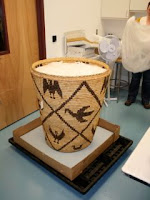This box of mystery is owned by the Department of Interior, and it was part of a larger project to rehouse over 800 baskets in the collection. When we saw this box, we had no idea what was inside, and little did we know what we would find.
 |
| The very large cardboard box. |
When the lid was finally pried off and the tape released, all that could be seen was the lid to a preposterously large basket. The lid seemed lost as clearly there was damage. A rim somewhere was broken, and was now just resting on the lid. The basket below was wrapped and appeared protected. Perhaps too protected, as no one had any idea what it was and it had never been unwrapped during a time when any present DOI staff member could remember!
Finally, it was time to see what we had. The box was carefully brought into the workspace and the outer cardboard walls and layers of wrapping materials were removed. The lid of the basket was lifted, to find that the entire basket was full of polyester batting!
What we found was a wonderfully preserved coil construction basket with slightly tapering sides, covered with images of several birds within a diamond lattice design. The birds were depicted as flying or swimming, and some with wings raised. The records showed that it was believed to be a Tohono O'odham basket, possibly made with yucca, Devil's claw and cattails. If you are not familiar with the Tohono O'odham, they are a people of the desert southwest, living in an area at the southern border of Arizona. Tohono O'odham means "desert people" in their language, and they are well-known for their contemporary coiled basketry.
 |
| One of the many birds. |
The materials used to construct the basket were in good shape, however, it is the shape and overall weight of the basket was not helping it. The lower third of the basket was buckling under its own weight, and in a matter of time, tears and weak areas were going to develop. Certainly from the photos you can see this basket is incredibly large, to be specific it was 91" tall and 84" around at its largest point.

Like all the other baskets treated in this collection, it (and its lid) was vacuumed, both inside and out. And then we had to address the most pressing issue, how to support the weakening base? It was, after all, the inherant-vice of the weight of the basket that was causing the bulges to appear. The flaring shape just was not conducive of its size and weight.
 |
| The loose band of coiling was found to be part of the lid's internal rim. It was determined to keep the rim with the lid but not reattacted. |
Supporting the lower sides, both inside and outside, was the decision made and was no easy feat when tackling such a large artifact. What was decided was to produce a "girdle" of sorts. The girdle would wrap around the outer surface, while internal braces were positioned inside. Below are images of the various steps.
 |
| Blue board was scored at even intervals. Here Shaun and Toosie are positioning the boards. |
 |
| The measured boards were secured and lined with Ethafoam sheeting. |
 |
| Shaun and Ron Harvey doing final adjustments. |
 |
| The ends were trimmed diagonally for a snug fit. |
 |
| Internal supports that braced the interior sides. |
 |
| Shaun adjusting the securing outer straps. |
 |
| The rehoused, and now fully supported basket! |

 |
| The basket along with the batting that was inside. |
The basket is still a mystery in that we are not sure what it was specifically made for, when exactly it was made, or even if it was made by a Tohono O'odham member. The Tohono O'odham are possibly the largest seller of Native baskets, so they not only produced the baskets for traditional utilitarian purposes, they also made them for ritual uses and to sell to tourists. A basket of this size is not typical, so I wonder was it made for collecting a lot of beans? Or perhaps a huge laundry hamper for a family with a bunch of kids? Or perhaps it is so unique because it was made for a ritual or particular occasion, if so, what was its purpose?
_____________________________Gwen Spicer is a textile conservator in private practice. Spicer Art Conservation specializes in textile conservation, object conservation, and the conservation of works on paper. Gwen's innovative treatment and mounting of flags and textiles is unrivaled. To contact her, please visit her website.







"Papago" is considered somewhat derogatory by the tribe. It is a name given to them by other people, and is outdated and mostly abandoned decades ago. The name of the tribe is Tohono O'Odham, which means Desert People in their own language. You could contact the Tohono O'Odham Cultural Center Museum for help about the basket's purpose.
ReplyDeleteThank you so much for the information about the proper tribe name. We have changed the blog entry to reflect the proper name. There are few written sources about baskets of these types, and those that I had access to were written while the term "Papago" was used. Thank you again for the update.
Delete